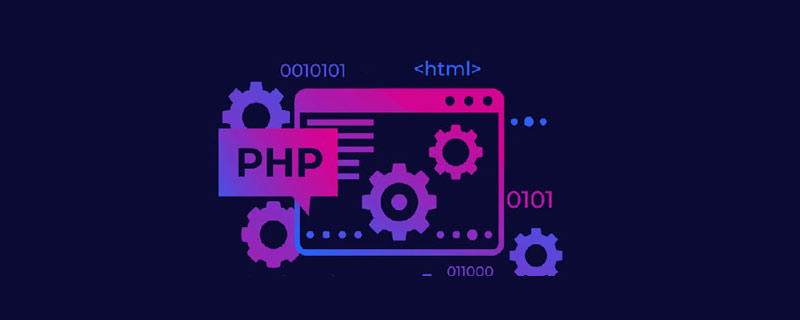詳述PHP適配器模式(附程式碼範例)
這篇文章為大家帶來了關於php的相關知識,其中主要跟大家聊一聊PHP適配器模式,還有程式碼範例,有興趣的朋友下面一起來看一下吧,希望對大家有幫助。

PHP 適配器模式解說與程式碼範例
適配器是一種結構型設計模式, 它能使不相容的對象能夠相互合作。
適配器可擔任兩個物件間的封裝器, 它會接收對於一個物件的調用, 並將其轉換為另一個物件可識別的格式和介面。
複雜度:******
流行度:******
使用範例: 適配器模式在PHP 程式碼中很常見。 基於一些遺留程式碼的系統常常會使用該模式。 在這種情況下, 適配器讓遺留程式碼與現代的類別得以相互合作。
識別方法: 適配器可以透過以不同抽像或介面類型實例為參數的建構子來識別。 當適配器的任何方法被呼叫時, 它會將參數轉換為適當的格式, 然後將呼叫導向至其封裝物件中的一個或多個方法。
真實世界範例
適配器允許你使用第三方或遺留系統的類, 即使它們與你的程式碼不相容。例如, 你可以建立一系列特殊的封裝器, 來讓應用程式所發出的呼叫與第三方類別所要求的介面與格式適配, 而無需重寫應用程式的通知介面以使其支援每個第三方服務(如釘釘、 微信、 簡訊或其他任何服務)。
index.php: 真實世界範例
<?php
namespace RefactoringGuru\Adapter\RealWorld;
/**
* The Target interface represents the interface that your application's classes
* already follow.
*/
interface Notification
{
public function send(string $title, string $message);
}
/**
* Here's an example of the existing class that follows the Target interface.
*
* The truth is that many real apps may not have this interface clearly defined.
* If you're in that boat, your best bet would be to extend the Adapter from one
* of your application's existing classes. If that's awkward (for instance,
* SlackNotification doesn't feel like a subclass of EmailNotification), then
* extracting an interface should be your first step.
*/
class EmailNotification implements Notification
{
private $adminEmail;
public function __construct(string $adminEmail)
{
$this->adminEmail = $adminEmail;
}
public function send(string $title, string $message): void
{
mail($this->adminEmail, $title, $message);
echo "Sent email with title '$title' to '{$this->adminEmail}' that says '$message'.";
}
}
/**
* The Adaptee is some useful class, incompatible with the Target interface. You
* can't just go in and change the code of the class to follow the Target
* interface, since the code might be provided by a 3rd-party library.
*/
class SlackApi
{
private $login;
private $apiKey;
public function __construct(string $login, string $apiKey)
{
$this->login = $login;
$this->apiKey = $apiKey;
}
public function logIn(): void
{
// Send authentication request to Slack web service.
echo "Logged in to a slack account '{$this->login}'.\n";
}
public function sendMessage(string $chatId, string $message): void
{
// Send message post request to Slack web service.
echo "Posted following message into the '$chatId' chat: '$message'.\n";
}
}
/**
* The Adapter is a class that links the Target interface and the Adaptee class.
* In this case, it allows the application to send notifications using Slack
* API.
*/
class SlackNotification implements Notification
{
private $slack;
private $chatId;
public function __construct(SlackApi $slack, string $chatId)
{
$this->slack = $slack;
$this->chatId = $chatId;
}
/**
* An Adapter is not only capable of adapting interfaces, but it can also
* convert incoming data to the format required by the Adaptee.
*/
public function send(string $title, string $message): void
{
$slackMessage = "#" . $title . "# " . strip_tags($message);
$this->slack->logIn();
$this->slack->sendMessage($this->chatId, $slackMessage);
}
}
/**
* The client code can work with any class that follows the Target interface.
*/
function clientCode(Notification $notification)
{
// ...
echo $notification->send("Website is down!",
"<strong style='color:red;font-size: 50px;'>Alert!</strong> " .
"Our website is not responding. Call admins and bring it up!");
// ...
}
echo "Client code is designed correctly and works with email notifications:\n";
$notification = new EmailNotification("developers@example.com");
clientCode($notification);
echo "\n\n";
echo "The same client code can work with other classes via adapter:\n";
$slackApi = new SlackApi("example.com", "XXXXXXXX");
$notification = new SlackNotification($slackApi, "Example.com Developers");
clientCode($notification);Output.txt: 執行結果
Client code is designed correctly and works with email notifications: Sent email with title 'Website is down!' to 'developers@example.com' that says '<strong style='color:red;font-size: 50px;'>Alert!</strong> Our website is not responding. Call admins and bring it up!'. The same client code can work with other classes via adapter: Logged in to a slack account 'example.com'. Posted following message into the 'Example.com Developers' chat: '#Website is down!# Alert! Our website is not responding. Call admins and bring it up!'.
概念範例
#本例說明了適配器設計模式的結構並重點回答了下面的問題:
- 它由哪些類別組成?
- 這些類別扮演了哪些角色?
- 模式中的各個元素會以何種方式相互關聯?
了解模式的結構後, 你可以更輕鬆地理解以下基於真實世界的 PHP 應用案例。
index.php: 概念範例
<?php
namespace RefactoringGuru\Adapter\Conceptual;
/**
* The Target defines the domain-specific interface used by the client code.
*/
class Target
{
public function request(): string
{
return "Target: The default target's behavior.";
}
}
/**
* The Adaptee contains some useful behavior, but its interface is incompatible
* with the existing client code. The Adaptee needs some adaptation before the
* client code can use it.
*/
class Adaptee
{
public function specificRequest(): string
{
return ".eetpadA eht fo roivaheb laicepS";
}
}
/**
* The Adapter makes the Adaptee's interface compatible with the Target's
* interface.
*/
class Adapter extends Target
{
private $adaptee;
public function __construct(Adaptee $adaptee)
{
$this->adaptee = $adaptee;
}
public function request(): string
{
return "Adapter: (TRANSLATED) " . strrev($this->adaptee->specificRequest());
}
}
/**
* The client code supports all classes that follow the Target interface.
*/
function clientCode(Target $target)
{
echo $target->request();
}
echo "Client: I can work just fine with the Target objects:\n";
$target = new Target();
clientCode($target);
echo "\n\n";
$adaptee = new Adaptee();
echo "Client: The Adaptee class has a weird interface. See, I don't understand it:\n";
echo "Adaptee: " . $adaptee->specificRequest();
echo "\n\n";
echo "Client: But I can work with it via the Adapter:\n";
$adapter = new Adapter($adaptee);
clientCode($adapter);#Output.txt: 執行結果
Client: I can work just fine with the Target objects: Target: The default target's behavior. Client: The Adaptee class has a weird interface. See, I don't understand it: Adaptee: .eetpadA eht fo roivaheb laicepS Client: But I can work with it via the Adapter: Adapter: (TRANSLATED) Special behavior of the Adaptee.
推薦學習:《PHP影片教學》
以上是詳述PHP適配器模式(附程式碼範例)的詳細內容。更多資訊請關注PHP中文網其他相關文章!

熱AI工具

Undresser.AI Undress
人工智慧驅動的應用程序,用於創建逼真的裸體照片

AI Clothes Remover
用於從照片中去除衣服的線上人工智慧工具。

Undress AI Tool
免費脫衣圖片

Clothoff.io
AI脫衣器

AI Hentai Generator
免費產生 AI 無盡。

熱門文章

熱工具

記事本++7.3.1
好用且免費的程式碼編輯器

SublimeText3漢化版
中文版,非常好用

禪工作室 13.0.1
強大的PHP整合開發環境

Dreamweaver CS6
視覺化網頁開發工具

SublimeText3 Mac版
神級程式碼編輯軟體(SublimeText3)
 適用於 Ubuntu 和 Debian 的 PHP 8.4 安裝和升級指南
Dec 24, 2024 pm 04:42 PM
適用於 Ubuntu 和 Debian 的 PHP 8.4 安裝和升級指南
Dec 24, 2024 pm 04:42 PM
適用於 Ubuntu 和 Debian 的 PHP 8.4 安裝和升級指南
 如何設定 Visual Studio Code (VS Code) 進行 PHP 開發
Dec 20, 2024 am 11:31 AM
如何設定 Visual Studio Code (VS Code) 進行 PHP 開發
Dec 20, 2024 am 11:31 AM
如何設定 Visual Studio Code (VS Code) 進行 PHP 開發












